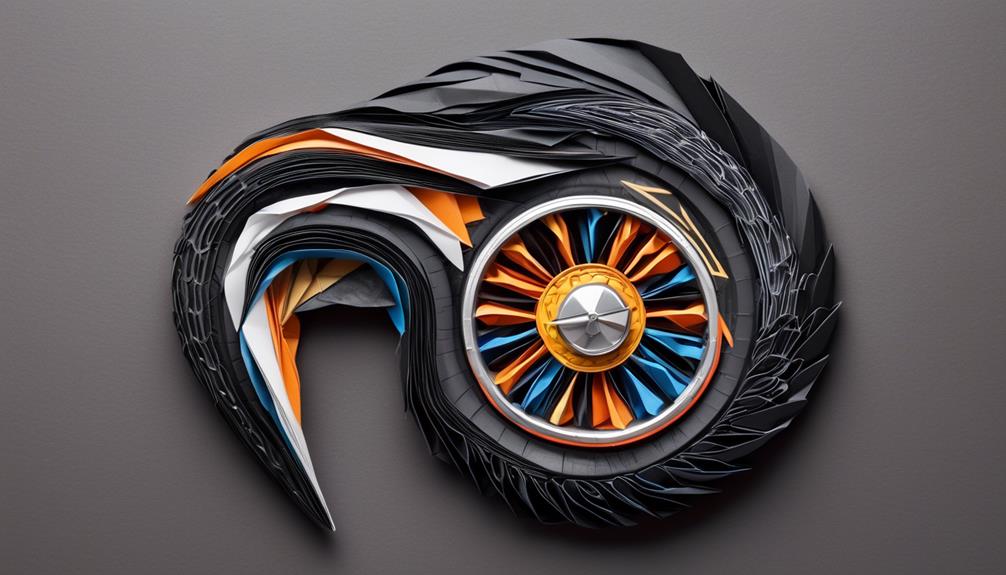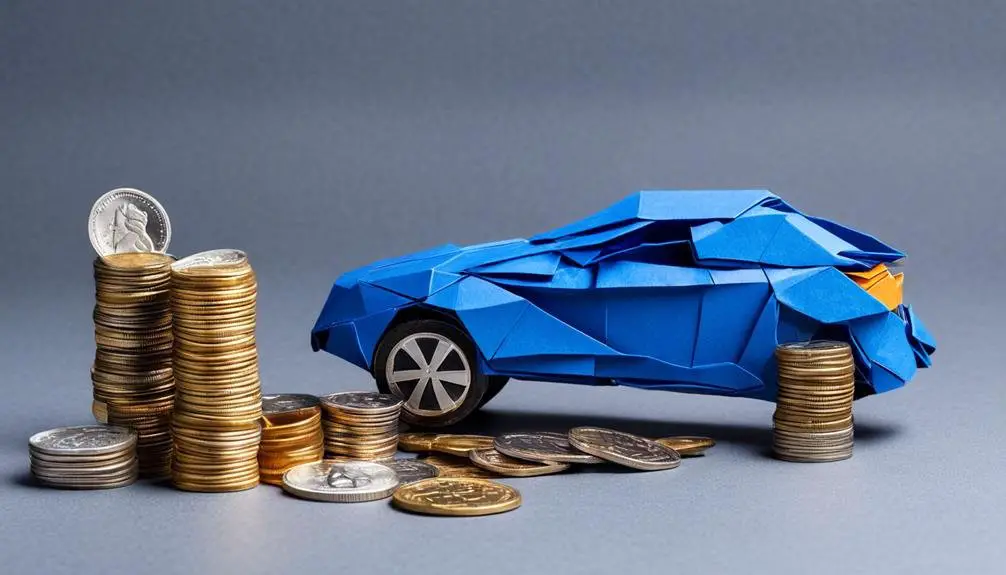Shaft-driven motorcycles excel in reliability with minimal maintenance needs and a smooth, comfortable ride due to reduced vibrations. However, customization options may be limited, impacting gear ratios and performance tuning possibilities. Weight distribution is essential for ideal handling, affecting stability and traction. Consider the initial higher cost against potential long-term savings and repair expenses. To explore further insights on the advantages and challenges of shaft-driven motorcycles, keep in mind the balance between reliability, customization limitations, weight distribution, and cost considerations.
Takeaways
- Reliability and durability for long-distance touring.
- Smooth ride with reduced vibrations.
- Cleaner rear wheel and less maintenance.
- Limited customization options and complex modifications.
- Higher initial cost but lower long-term maintenance expenses.
Reliability
When considering the reliability of shaft-driven motorcycles, it is important to evaluate their performance under various riding conditions. Shaft-driven motorcycles offer several advantages over chain-driven counterparts when it comes to durability and maintenance.
The enclosed design of the shaft drive system protects it from external elements, reducing the risk of damage and wear. This feature is particularly beneficial for riders who frequently encounter rough terrain or adverse weather conditions.
Additionally, shaft-driven motorcycles require less frequent maintenance compared to chain-driven models. The sealed nature of the shaft drive system means that it does not need regular lubrication or adjustments, resulting in lower ongoing maintenance costs and time investments for riders. This increased reliability and reduced maintenance make shaft-driven motorcycles a popular choice for long-distance touring and commuting purposes.
However, it is essential to note that while shaft drives are generally reliable, they can be more complex and costly to repair in the event of a malfunction compared to chain drives. Regular inspections and servicing by qualified technicians are vital to maintain the continued reliability and performance of shaft-driven motorcycles.
Smooth Ride
When considering the smooth ride of shaft-driven motorcycles, several key points come to light.
To begin with, shaft-driven systems greatly diminish vibrations, leading to a more comfortable experience for the rider.
Additionally, the minimal maintenance required for these systems guarantees a consistent and hassle-free ride, while the direct power transfer results in efficient performance on the road.
Vibration Reduction
Enhancing rider comfort and reducing vibrations are key benefits of shaft-driven motorcycles, contributing to a smoother riding experience. Shaft-driven motorcycles are designed to minimize vibrations, providing a more enjoyable and comfortable ride for the rider.
Here are three ways in which shaft-driven motorcycles reduce vibrations:
- Direct Power Transfer: Shaft-driven motorcycles have a direct power transfer from the engine to the rear wheel, which helps in reducing the number of components that can cause vibrations. This direct transfer results in a smoother power delivery and a more stable ride.
- Balanced Design: The shaft drive system is inherently balanced, leading to fewer vibrations compared to chain or belt-driven motorcycles. This balanced design reduces the amount of vibration that is transmitted to the rider, resulting in a more comfortable riding experience.
- Low Maintenance: Unlike chain-driven motorcycles that require regular adjustments and lubrication to reduce vibrations, shaft-driven motorcycles offer lower maintenance requirements. This contributes to a consistently smooth ride over time, without the need for frequent adjustments.
Minimal Maintenance
Shaft-driven motorcycles offer a smooth ride with minimal maintenance requirements, making them a convenient choice for riders seeking a hassle-free experience. Unlike chain-driven motorcycles that require regular lubrication, adjustment, and replacement, shaft-driven systems are enclosed and operate in an oil bath, reducing the need for frequent maintenance. This enclosed design protects the system from dirt, debris, and weather elements, further enhancing its durability and longevity.
The reduced maintenance needs of shaft-driven motorcycles translate to cost savings for riders over time. With fewer components exposed to wear and tear, the overall upkeep expenses decrease, contributing to a more economical ownership experience. Additionally, the simplicity of maintenance tasks on shaft-driven bikes, such as checking the oil level and changing it at recommended intervals, adds to the convenience factor for riders.
Direct Power Transfer
Achieving a seamless and vibration-free ride, the direct power transfer of shaft-driven motorcycles enhances overall riding comfort and stability. This system offers several advantages that contribute to a smoother riding experience:
- Reduced Vibrations: Unlike chain or belt-driven systems, shaft-driven motorcycles experience minimal vibrations. This results in a more comfortable ride for the rider, especially on long journeys where vibrations can help guarantee fatigue and discomfort.
- Consistent Power Delivery: The direct power transfer from the engine to the rear wheel ensures a consistent and smooth delivery of power. This feature is particularly beneficial for maintaining stability during acceleration, deceleration, and while cruising at various speeds.
- Low Maintenance: Compared to chain-driven motorcycles, shaft-driven bikes require less maintenance. The enclosed nature of the shaft drive means less exposure to external elements, reducing the need for frequent cleaning and adjustments. This leads to a more hassle-free ownership experience for riders seeking a low-maintenance option.
Reduced Maintenance
When it comes to discussing the reduced maintenance aspect of shaft-driven motorcycles, two key points stand out.
To begin with, the absence of a chain on these bikes greatly reduces the need for chain maintenance, eliminating the regular cleaning, lubricating, and tension adjustments associated with chain-driven systems.
Additionally, the design of shaft-driven motorcycles results in a cleaner rear wheel, as there is no chain to fling grease or collect debris, ultimately reducing the time and effort required for cleaning and maintaining the bike.
Less Chain Maintenance
One of the advantages of shaft-driven motorcycles is the reduced maintenance required for the drive system compared to chain-driven motorcycles. This feature appeals to riders seeking a hassle-free ownership experience.
The following points highlight the benefits of less chain maintenance:
- No Chain Lubrication: Shaft-driven motorcycles eliminate the need for regular chain lubrication, which is necessary for chain-driven bikes. This saves time and effort for riders, as they do not have to frequently clean and lubricate the chain to prevent wear and maintain smooth operation.
- Minimal Adjustment Needed: Chains on motorcycles require periodic adjustment to maintain proper tension. In contrast, shaft-driven systems are typically self-adjusting, reducing the need for manual adjustments and ensuring consistent performance over time.
- Longer Lifespan: The enclosed nature of shaft-driven systems protects the components from external elements, leading to a longer lifespan compared to exposed chains that are susceptible to dirt, water, and debris. This results in reduced maintenance costs and downtime for riders.
Cleaner Rear Wheel
The shaft-driven motorcycles offer the benefit of a cleaner rear wheel, contributing to reduced maintenance requirements for riders. Unlike chain-driven motorcycles that require frequent cleaning and lubrication to prevent dirt and debris buildup, shaft-driven motorcycles have a closed system that protects the rear wheel from external elements. This leads to a cleaner appearance and smoother operation of the rear wheel over time.
The cleanliness of the rear wheel on shaft-driven motorcycles translates to fewer maintenance tasks for riders. Without the need for regular chain adjustments, cleaning, and lubrication, riders can enjoy a more hassle-free ownership experience. Additionally, the reduced maintenance requirements result in lower overall maintenance costs and less time spent on upkeep, allowing riders to focus more on enjoying the ride.
Limited Customization
With shaft-driven motorcycles, customization options are limited compared to chain or belt-driven bikes. While shaft drives offer advantages such as low maintenance and cleaner rear wheels, they come with drawbacks regarding customization possibilities.
Here are some reasons why customization is limited with shaft-driven motorcycles:
- Limited Gear Ratios: Shaft-driven motorcycles have limited options for changing gear ratios compared to chain or belt-driven bikes. This can restrict the ability to fine-tune the bike's performance to suit specific riding styles or preferences.
- Complex Modifications: Making modifications to shaft-driven systems can be more complex and costly than with chain or belt drives. The design of the shaft drive system may require specialized parts and expertise, making customization less accessible to the average rider.
- Aesthetics: The bulky nature of shaft drive systems can limit the aesthetic customization possibilities of the motorcycle. Customizing the rear end of the bike, in particular, may be challenging due to the space taken up by the shaft and its components.
Weight Distribution
Achieving ideal weight distribution is a crucial factor in the design and performance of shaft-driven motorcycles. The placement of components such as the engine, transmission, and shaft drive system has a notable impact on how weight is distributed across the motorcycle.
Unlike chain or belt-driven motorcycles where the weight tends to be more centralized, shaft-driven motorcycles often have a more rearward weight bias due to the positioning of the shaft drive system.
This rearward weight bias can have both advantages and disadvantages. On the positive side, having more weight towards the rear wheel can improve traction, especially during acceleration, as it helps to increase the downward force on the rear tire. Additionally, it can contribute to stability, particularly when maneuvering through corners.
However, a potential downside of this weight distribution is that it may affect the bike's agility and maneuverability, making it slightly less responsive in certain riding conditions.
Cost Considerations
Cost efficiency is an important factor to take into account when evaluating the feasibility of shaft-driven motorcycles. When considering the cost implications of opting for a shaft-driven system, several key points should be considered:
- Higher Initial Cost: Shaft-driven motorcycles tend to have a higher initial purchase price compared to chain-driven counterparts. The complexity of the shaft system contributes to this higher cost.
- Lower Maintenance Costs: While the initial investment may be higher, shaft-driven motorcycles often require less maintenance than chain-driven models. This can result in long-term cost savings due to reduced maintenance needs.
- Repair Expenses: In the event of a malfunction or damage to the shaft drive system, repair costs can be substantial. Specialized tools and expertise may be required, potentially increasing repair expenses compared to chain-driven systems.
Considering these cost factors is important for individuals weighing the financial implications of choosing a shaft-driven motorcycle over other options.
Frequently Asked Questions
Can Shaft Driven Motorcycles Be Easily Converted to Chain or Belt Drive?
Converting a shaft-driven motorcycle to a chain or belt drive can be complex due to the differences in design and functionality. It often requires significant modifications to the bike's structure and components, making the process challenging and potentially costly.
How Does Shaft Drive Affect Cornering and Handling?
Shaft drive affects cornering and handling in motorcycles by offering smoother power delivery and reduced maintenance compared to chain or belt drives. However, it can also add weight and affect the bike's responsiveness in tight turns.
Are Shaft Driven Motorcycles Harder to Repair in Case of Damage?
When it comes to repair, shaft-driven motorcycles can be more complex due to the specialized nature of the drivetrain system. Repairing damage may require specific tools and expertise, potentially leading to higher repair costs compared to chain or belt-driven systems.
Do Shaft Driven Motorcycles Have a Different Feel Compared to Chain-Driven Ones?
Shaft-driven motorcycles typically provide a smoother and more consistent power delivery compared to chain-driven ones. This results in a different feel for the rider, with reduced maintenance requirements and less susceptibility to dirt and debris.
Are There Any Aftermarket Customization Options Available for Shaft Driven Bikes?
Aftermarket customization options for shaft-driven motorcycles are available, catering to various preferences and needs of riders. These options can include performance upgrades, aesthetic modifications, and accessories, allowing riders to personalize their bikes to suit their style and requirements.
Conclusion
To sum up, shaft driven motorcycles offer advantages such as increased reliability, smoother rides, and reduced maintenance requirements.
However, they also have limitations, including limited customization options, potential issues with weight distribution, and higher initial costs.
It is important for riders to carefully consider these factors when deciding whether a shaft driven motorcycle is the right choice for their needs.









